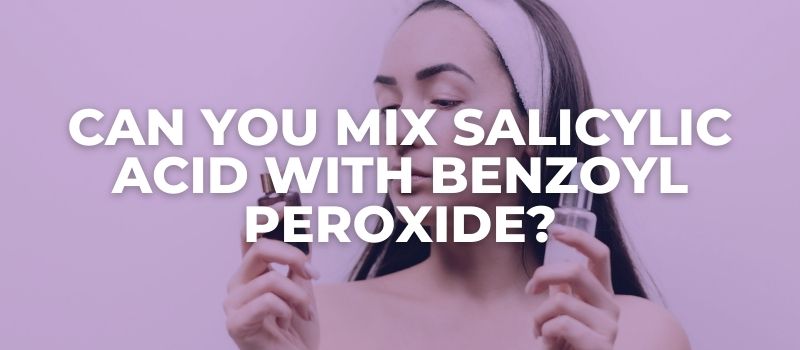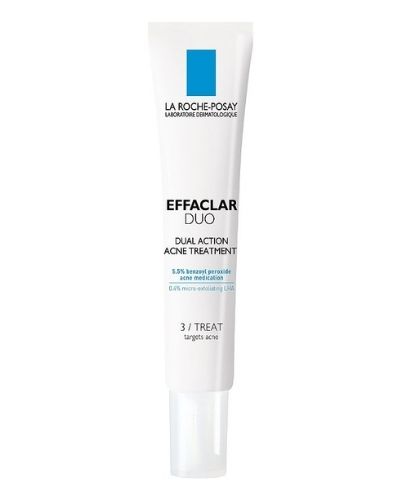Salicylic acid and benzoyl peroxide can be used in the same skincare routine to improve the appearance of inflammatory skin conditions such as acne.
However, although compatible, salicylic acid and benzoyl peroxide are two ingredients that often raise doubts about whether they can be safely combined.
While the answer is yes, this doesn’t mean that you can’t go wrong with them and potentially exacerbate your acne symptoms and risk developing more serious skin concerns such as a compromised skin barrier.
Therefore, in this article, we will talk about the benefits and risks of using salicylic acid and benzoyl peroxide together, as well as how to safely combine these two actives for best results and no unwanted reactions.

How Does Salicylic Acid Work?

Salicylic acid is a BHA and an oil-soluble ingredient that cuts through the superficial skin oil and dissolves cellular debris made up of dead skin cells, white blood cells, and oil, responsible for causing stiff clogs inside the pores.
Once the pores are clear, the natural oil will flow freely toward the skin’s surface, where it will lubricate the skin and protect it from external aggressors instead of remaining stuck inside and causing concerns such as whiteheads, blackheads, and acne.
Salicylic acid naturally occurs in willow bark derived from the willow tree, and has been used for its medicinal properties for centuries.
In the past, people would chew on willow bark to alleviate pain and reduce inflammation while also applying it topically to treat skin conditions such as bug bites, wounds, and rashes.
In modern times, salicylic acid is used to soothe inflammatory skin conditions thanks to its soothing, anti-inflammatory properties.
Some benefits of using salicylic acid include:
- Relieved skin inflammation.
- Cleared and refined pores.
- Reduced appearance of whiteheads, blackheads, and acne.
RELATED: Best Skincare Products For Acne-Prone Skin.
How Does Benzoyl Peroxide Work?

Benzoyl peroxide is an ingredient found in skincare products such as cleansers, gels, and creams designed to treat acne.
This industrial chemical belongs to the peroxide family of chemicals and was first made in 1905, but it didn’t come into medical use until the 1930s.
Benzoyl peroxide has small molecules that enable it to travel deeper inside the pores, but unlike salicylic acid, it doesn’t dissolve the cellular debris that’s causing a clog.
Instead, benzoyl peroxide carries oxygen into the pores to destroy the airless environment the acne-causing bacteria need to survive and proliferate.
Additionally, benzoyl peroxide is also a keratolytic agent, which means it has the ability to help accumulated dead skin cells on the skin’s surface shed more easily and lessen the thickness of the outermost skin layer.
This action will prevent pores from clogging, which will reduce the chances of acne formation down the line.
However, benzoyl peroxide isn’t an exfoliating ingredient, and it doesn’t promote cellular turnover, which is one of the main traits of exfoliating components.
As such, it can work alongside exfoliating components to complement their action and target inflammatory skin concerns such as acne on a deeper level.
Some benefits of using benzoyl peroxide include:
- Reduced acne.
- Relieved redness.
- Refined pores.
- Balanced oil production.
RELATED: Best Products For Cystic Acne.
Can You Use Salicylic Acid and Benzoyl Peroxide Together?
You can safely use benzoyl peroxide and salicylic acid in the same skincare routine to reduce the appearance of inflamed and non-inflamed acne, including whiteheads, blackheads, pustules, papules, and cysts.
Both ingredients are effective at combating the root of the acne cause, with benzoyl peroxide working deep within pores to destroy the airless environment bacteria need to survive and salicylic acid dissolving the cellular debris that’s causing clogged pores and providing the bacteria with a food source.
However, while using them together may enhance their effectiveness, it could also increase the risk of irritation due to their method of action.
Therefore, when combining them in the same routine, it’s crucial to do so with caution to avoid symptoms of dryness, irritation, and a compromised skin barrier.
SN: While it’s safe to use salicylic acid with benzoyl peroxide, there are some ingredients you should never mix with salicylic acid.
The Benefits of Using Salicylic Acid and Benzoyl Peroxide
Salicylic acid and benzoyl peroxide can be a great combination of active ingredients for reducing the severity of acne.
The two ingredients have specific actions that complement each other on the acne-fighting journey.
Salicylic acid will dissolve the gunk that’s preventing your natural oil from flowing freely through the pores. At the same time, benzoyl peroxide will infuse the clogged passages with oxygen and provide an antibacterial boost while destroying the acne-causing bacteria’s preferred living environment.
Here are a few benefits of combining salicylic acid with benzoyl peroxide in your anti-acne regimen:
- Faster Acne Reduction: Combining salicylic acid with benzoyl peroxide will result in a faster acne reduction compared to using either ingredient separately.
- Dual Acne Solution: The two ingredients work together in the fight against acne. Salicylic acid works in the superficial layers of the pores, while benzoyl peroxide operates deeper within the pores.
- Antibacterial Benefits: Both benzoyl peroxide and salicylic acid have antibacterial properties, giving your skin an extra boost of protection against acne-causing bacteria.
- Anti-inflammatory Effect: Both salicylic acid and benzoyl peroxide help soothe and reduce the appearance of redness and inflammation associated with acne.
RELATED: Best Products to Instantly Soothe Irritated Skin.
The Side Effects of Using Salicylic Acid With Benzoyl Peroxide
While using salicylic acid and benzoyl peroxide together can be very helpful for getting rid of acne, this combination doesn’t come without potential side effects.
Here are a few things you should pay attention to when mixing salicylic acid with benzoyl peroxide:
Dryness: Both salicylic acid and benzoyl peroxide can dry out the skin. This can be particularly problematic for individuals with already dry skin but also for those with oily skin, as excessive dryness can disrupt the skin’s balance and lead to increased oil production. It’s crucial to monitor your skin for signs of excessive dryness when using these ingredients together.
Irritation: Persistent dryness is a sign that the skin cannot hold on to moisture, which can cause it to become irritated and inflamed. To avoid this, make sure to finish off your anti-acne skincare regimen with a nourishing, non-comedogenic moisturizer.
Damaged Skin Barrier: Impaired skin barrier function often presents as persistently irritated, red, and inflamed skin. In extreme cases, it can cause a burning sensation even when washing your face with plain water. The main causes of a damaged skin barrier are excessive dryness and prolonged irritation.
Flaking: This is a common reaction when the skin is adjusting to active ingredients like benzoyl peroxide and salicylic acid. Be vigilant for moderate to severe flaking and reduce or stop use if this occurs.
RELATED: How to Stop Your Face From Peeling?
How to Use Salicylic Acid With Benzoyl Peroxide?

Salicylic acid and benzoyl peroxide can be used together in several different ways to maximize the potency of your anti-acne skincare regimen:
1. Sequential Application in the Same Routine
Method:
- Step 1: Apply a salicylic acid toner to clear damp skin.
- Step 2: Wait for 3-5 minutes to allow the toner to penetrate.
- Step 3: Apply a benzoyl peroxide gel or cream.
- Step 4: Finish with a moisturizer to prevent dryness.
Pros:
- Targeted Treatment: This method allows each ingredient to work effectively on the skin.
- Controlled Application: You can manage the amount and concentration of each product, reducing the risk of irritation.
- Enhanced Effectiveness: Sequential applications can maximize the benefits of both ingredients.
Cons:
- Time-Consuming: Requires more time for application and waiting between steps.
- Risk of Dryness or Irritation: Using two active ingredients consecutively can be harsh on sensitive skin.
2. Benzoyl Peroxide as a Short-Term Mask
Method:
- Step 1: Apply benzoyl peroxide on clean, dry skin.
- Step 2: Leave it on for 5-10 minutes.
- Step 3: Rinse off the mask.
- Step 4: Apply a salicylic acid toner.
Pros:
- Reduced Irritation: Short contact with benzoyl peroxide minimizes the risk of irritation, making it suitable for sensitive skin.
- Deep Cleansing: The mask can provide a deep cleanse, effectively targeting acne-causing bacteria.
Cons:
- Less Potent for Severe Acne: This may not be as effective for more severe forms of acne due to limited exposure time.
- Additional Rinsing Step: Requires washing off the mask, adding an extra step to the routine.
3. Benzoyl Peroxide in a Cleanser Form
Method:
- Step 1: Use a benzoyl peroxide cleanser to wash your face.
- Step 2: Apply a leave-on salicylic acid toner on clean, damp skin.
- Step 3: Rinse or leave on the skin.
- Step 4: Follow up with a nourishing, non-comedogenic moisturizer to prevent dryness and irritation.
Pros:
- Efficient and Simple: Combines cleansing and treatment in fewer steps.
- Good for Oily Skin: The cleanser form can help control oil and reduce shine.
Cons:
- Limited Contact Time: Benzoyl peroxide in cleansers has less contact time with the skin, potentially reducing its effectiveness.
- Possibility of Over-Drying: Can be drying, especially if the benzoyl peroxide content in the product is high or the routine isn’t finished off a moisturizer.
With that said, although helpful in minimizing the severity of acne, benzoyl peroxide shouldn’t be a permanent step in your skincare routine.
Instead, it’s best to use it sparingly and slowly minimize and eventually stop using it completely when the acne is significantly healed.
This will give the good bacteria that reside on the skin a chance to balance themselves out and can help prevent issues such as compromised skin barrier, infections, and even allergic reactions down the line.
RELATED: 5 Reasons Your Skin is Always Dry (Even Though You Moisturize).

My name is Simone and I am a certified skin specialist. I created this website to teach my readers how to take great care of their skin and I also like to occasionally share my honest opinions on skincare products I’ve tried. You can learn more about me here.
